The run-up to every Olympics is marked by anxiety and controversy, but Rio de Janeiro has arguably outdone all of its predecessors on this score. Against a backdrop of economic recession, the impeachment of Brazil’s president Dilma Rousseff, a Zika epidemic, resurgent crime and water pollution, the city’s officials are not only having to fight off accusations of corruption, incompetence and unbalanced priorities, they are also battling to justify whether the Games were worth hosting in the first place.
In this polemical combat, the establishment – the Rio city government and the International Olympics Committee – argue the event boosts economic developments and raises the global profile of the host. Challenging this is an array of social activists, critical academics, political opponents, displaced residents and environmental campaigners who argue that the Olympics are disruptive, destructive and skewed to benefit a wealthy elite.
But beyond all the angry headlines, is it possible to assess exactly how this city of more than 6 million people has really been impacted – for good and bad – by the awarding of the Olympics in 2009? To assess this in the long term, it is necessary to go beyond the media furore and focus instead on the likely legacy for Rio’s residents.
One of the most controversial issues for years has, of course, been the question of displacement: just how many residents have been uprooted as a result of building projects around Rio for the Olympics, not to mention the 2014 football World Cup? Where have they been moved to, with what compensation – and who is benefitting from the property (often very central) that they left?
The numbers are contested. The city puts the numbers in the hundreds. On the other extreme is an estimate that Rio moved 22,100 families (average size of 3.5 people) in 2015, 20,200 families in 2014, 19,200 families in 2013 and more than 10,000 before then. This is the calculation of critics Lena Azevedo and Lucas Faulhaber in their book, Remoções no Rio Olímpico. Based on these figures, they say the current Rio mayor Eduardo Paes has far exceeded the city’s previous two big people-moving city bosses Carlos Lacerda (1961-1965) with 30,000 relocations and Pereira Passos (1902-1906), who dislodged 20,000 people. Paes says these numbers are grossly exaggerated by political opponents.
Then there is the issue of where resources are allocated, which again stirs up disputes. “Without question, the main beneficiaries of the Olympic-related investments have been construction firms, real-estate companies, private security firms, and industries related to gentrification and car-dependent landscapes,” notes Chris Gaffney, a researcher at the University of Zurich and a prominent critic of the Rio Games.
Nonsense, insists Paes, who says accusations that the Olympics favour the wealthy South Zone of the city are just plain wrong.
“There has never been so much transformation for poor people,” the mayor claims. “Seventy-five percent of my investment is in the north and west of the city. That’s where I get my votes.”
Although he has cosied up to property developers and construction firms, Paes says this has been done transparently and that it has benefited taxpayers because entrepreneurs have financed 58% of Games-related projects – which means there is less of a strain on the public purse than was the case during preparations for the World Cup.
But are poorer areas really sharing the Olympic benefits equally? The Guardian visited the five major venue clusters to find out.
Barra da Tijuca and the west
Despite the inflated, sprawling nature of the modern Olympics, the Rio Games have an evident geographic heart in the Barra da Tijuca/Jacarepaguá district on the western side of the city. Less clear is whether this location – site of the athletes’ village, Olympic Park and Olympic golf course – has been chosen to pump economic benefits throughout the entire city, or mainly to a wealthy elite.
No area has undergone such a dramatic transformation. Barra – which was mostly swampland and plantation 40 years ago – has long been the fastest developing region of Rio as it races towards a Miami-style vision of broad highways, mega-shopping malls and gated communities. The Olympics has supercharged that trend, thanks to an influx of public and private money to build stadiums, roads, water-treatment plants, electricity pylons and a metro extension.
Carlos Carvalho, one of the three biggest landowners in the area and a major investor in several Olympic projects, believes Barra’s growth has been accelerated by 30 years: “The most difficult part of the development plan was the service infrastructure, and the Olympics has brought that. It’s a billion-dollar jump,” he told the Guardian last year.
More controversially, Carvalho claimed his ultimate goal was to shift Rio’s centre to Barra, even if it meant evicting poorer communities to the periphery so that a “noble” elite had precedence.
He has subsequently been encouraged not to talk to the media – reportedly on the advice of Paes, who cut his political teeth in Barra and received donations from Carvalho and other donors for his re-election campaign. Shortly after winning the race, the mayor approved a controversial Olympic golf development and changed building codes so developers could construct taller towers in this coastal region. While the business community hopes economic opportunities will improve, social scientists and evicted residents are critical.
“Our community has been lost. We are living in containers while new houses are being built,” says Maria da Penha, a prominent member of the Vila Autódromo community’s resistance against relocation until her home was demolished.
“The Olympics is really bad – this is no legacy,” she continues. “Vila Autódromo has become an entirely new community: if you come and visit again, you won’t recognise anything. The history of Vila Autódromo will remain in our memories and we are trying to preserve its history, but nothing is left. Not one shop, nothing. Everything is new.”

For critics, this is one of many indicators that the city’s priorities are skewed towards the wealthy. “Barra has long been considered an ‘off world’ for Rio’s emerging upper-middle classes, and there was even a secession attempt in the 1980s,” says Gaffney. “As the rest of the city sees billions of public funds poured into the subsidisation of highways, shopping malls and spaces of elite privilege, there will inevitably be negative consequences as opportunity costs increase over time.”
Possible collusion between officials and developers is also being investigated. Two of the biggest partners in the Olympic Park developments – construction firms Odebrecht and Andrade Gutierrez – are separately implicated in the biggest bribery and kickback scandal in Brazil’s history: the Lava Jato (“Car wash”) investigation into accusations of wrongdoing at the oil company Petrobras. Prosecutors are examining whether similar wrongdoing took place on Olympics contracts.
While lawyer Jean Carlos Novaes claims Lava Jato documents reveal foul play in the bidding for Olympic construction contracts, he acknowledges that corruption is nothing new – and says it has merely been accelerated as a result of this mega-event. The mayor refutes these allegations. The Olympics, he says, will prove that not all projects in Brazil involve corruption.
In the business community, people are positive. Laudimiro Cavalcanti, director of the Rio Chamber of Commerce, believes it was natural for the city to use Barra as a dynamo for investment and development. Until now, she says, the big problem for the region was urban mobility – and this is being solved by the road building and metro extension.
“This will have a big impact on the neighbourhood. It will boost property values, help shopping centres, and bring growth to the real-estate market,” Cavalcanti predicts. “Barra is the region that will benefit most. There will be a boost for tourism in the area. And it will be good for Rio as a whole, because the city will be at the centre of the world’s attention.” JW
The port area and old city centre
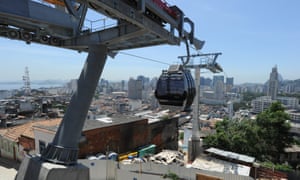
Arguably no area of Rio de Janeiro has undergone a more radical transformation in the years since the city won the right to host the Olympics than the port area – though this development is less an integral part of the Games themselves than a shop window for potential investors.
Once dominated by the Perimetral, a monstrous elevated highway that was finally torn down in 2014, this historic area has so far gained an expansive pedestrianised boulevard which serves as a disembarkation point for cruise ship passengers, a collection of striking museums, and the VLT light railway system – at a cost of R$1.15bn (£230m), its 17 miles of track will eventually connect the intercity bus station, the ferry terminal, the metro and the domestic airport.
The total cost of Meu Porto Maravilha (or “My Wonderful Port”, as this public-private partnership scheme is known) was estimated at R$8bn in June 2011 by Alberto Silva, the head of the development company set up by City Hall to manage the project. Already, around R$5bn has been spent, four years into this gargantuan 15-year plan.
In all, the project covers seven neighbourhoods. Mercedes Guimarães, 60, who has lived in the district of Gamboa on-and-off since the mid-1960s, says that a combination of official neglect and laws designed to preserve the facades of historic buildings had resulted in decades of disrepair. “Sometimes I hear people who don’t live here complain about the changes,” she says. “It could be better but for those who never got anything in the past, I think it is excellent.”
The Wonderful Port project covers a total area of five million square metres, and includes the city’s docks, its old slave market, its first favela, its samba school warehouses and the Praça Mauá, which now houses the Santiago Calatrava-designed Museum of Tomorrow (a building described as a cross between a solar-powered dinosaur and a giant air-conditioning unit).
One of the most controversial projects was the construction of a cable car across the Morro da Providência favela, at a cost of R$75m. Originally, the plans envisaged the removal of around a third of the neighbourhood’s 5,000 or so residents but, after locals fought back, that number was reduced – and around 140 homes were eventually destroyed, according to Amnesty International.
“Basic sanitation would have been more useful,” says Cosme Felippsen, a resident and tour guide. “But there was no dialogue and the government just did what it pleased.” With no takers as yet for its operating concession, some fear the cable car could stop running soon after the Games end.
For Pedro Moreira, president of the Rio branch of the Brazilian Architects’ Association, the main concern about the port area is whether the city has done enough to attract new residents. “We are worried about the lack of housing. At the moment, lots of companies and hotels are moving in, but it needs more residents for the neighbourhood to feel alive,” he says. Around 30,000 people live in the port area at present, but the development hopes to bring in another 70,000 over the next 10 years.
Isabel Dias, who recently bought a house in Providência with the aim of turning it into a social enterprise, says that so many big corporate investors – including a certain Donald Trump – were now involved in the project that she believes the area will attract new residents. “My concern is that local residents don’t lose out,” she says. “They are not really being included at the moment.” BD
Guanabara Bay
A clean-up of Guanabara Bay, which hosts three of the five Olympic sailing courses, was the most ambitious of the pledges made by Rio when it bid for the Games in 2009. But in the years since, the greatest hope has proved the biggest disappointment.
This vast body of water gave the city its name (the first Portuguese explorers to arrive here mistook it for the estuary of a mighty river, hence the misnomer Rio de Janeiro – January river), but the picture-postcard setting has never been quite what it seems. More recently, the stunning beauty of the bay – backdrop for some of Rio’s most spectacular sights – has been at odds with an often appalling stench of human waste and other forms of pollution.
This comes in part from the petrochemical industry that is a mainstay of the Rio economy. But the primary cause, particularly near the yachting courses, is the waste that flows into the bay from surrounding communities, many of which emerged during periods of unregulated urban growth.
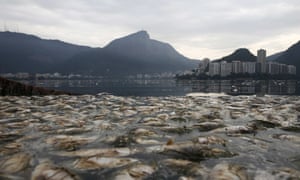
According to the state government (the tier of administration responsible for the water quality of the bay), there have been improvements. Since 2009, the state-run water company CEDAE claims to have spent more than £500m on tripling sewage treatment in the bay. Among the most recent improvements is a clean-up of the Marina da Glória, complete with a new sewerage system to deal with the foul sludge that used to gush into the harbour.
Despite this, only 49% of the sewage that flows into Guanabara Bay is treated. In its hosting document, the Olympic organisers promised above 80%. Specifically, they said they would build two major river treatment units: one on the Rio Irajá that would deal with 11% of the waste, and another on the Rio Pavuna, which would handle 22%.
There were tenders, and environmental licences were issued, but the state government failed to come up with the funds. Irajá was built but has yet to begin operations; Pavuna never even got started.
“Guanabara Bay is still a latrine,” says the conservationist Mario Moscatelli, who makes helicopters monitoring trips of the region every month. “It’s as if they had promised a Porsche V16 and are now giving us a Volkswagen 1200.”
The consequences are an embarrassment to the city, and a worry for Olympic participants. The stink of the bay, which is worst near major population centres, frequently assaults the nostrils of visitors on the journey from Galeão international airport to the city centre.
Of greater impact on the competition, sailors in test events have complained that along with the bad smell, they have to deal with debris – including furniture, plastic bags and dead fish – that could impede their vessels. Nets, barriers and rubbish-fishing vessels are likely to provide a temporary fix.
Most alarming and harder to overcome, however, are the health risks, with several recent studies indicating harmful levels of viruses, fecal coliform bacteria and even super bacteria in the waters.
While the technology to resolve these problems exists, the budget and political will appear to be lacking. David Zee, oceanography professor at the State University of Rio de Janeiro, says the same pattern was evident at other sites that were supposed to have been improved in time for the Games.
“The legacy that was most forgotten – even though it was the most commented on – was the environmental legacy,” Zee says. “When it comes to waterways – Guanabara Bay, the Rodrigo de Freitas lagoon, the Complexo Lagunar de Jacarepaguá – the state government did nothing. It’s their modus operandi: a lot of talking and no action.”
This was the case even before the current economic downturn. With Brazil now suffering its deepest recession in decades and Rio particularly badly hit, the prospects of a clean-up look more distant than ever. But the TV images will probably still look stunning – as long as viewers do not look too closely and it doesn’t rain, which always increases waste flows. JW
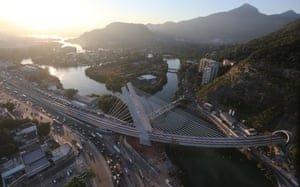
The South Zone
On the surface, there has been little change to Rio’s wealthy South Zone, home not only of the world famous Copacabana and Ipanema beaches but also Rocinha, which is often described as the largest favela in Latin America.
With the area already highly developed and only a handful of Olympic events taking place here (beach volleyball, rowing and marathon swimming), most of the changes have been taking place out of full view – although these do include what the Rio state government is calling the “greatest transport legacy” of the Olympic Games.
An extension to Rio’s current two-line metro system is due to open days before the Olympics, to carry Games ticket-holders from Ipanema to Barra da Tijuca. The R$9.7bn extension will open to the public in September and is expected to carry more than 300,000 people a day. Critics, however, argue that it will primarily benefit an already wealthy area of the city.
One of the major question marks over Rio’s Olympic bid was security. By the time it secured the Games in 2009, violent crime was down significantly on its mid-1990s levels – but by any international comparison, Rio was still a dangerous city.
Officials promised to set up “police pacification units” (UPPs) in 40 of Rio’s 1,000 favelas by the time of the Games, installing a police presence for the very first time in previously gang-controlled communities. Since the first UPP was established in Santa Marta, a favela in the South Zone, 38 communities have now been “pacified”.
Despite initial successes in community policing, many favela residents have become disillusioned after years of aggressive tactics by UPP officers. “The police is still a violent, military organisation,” says Gabriel Siqueira, 27, from the Federation of Rio de Janeiro’s Favela Associations. “It doesn’t have the capacity to implement a policy like pacification.” Others criticise the failure of the local government to deliver promised services, such as running water, safe electricity and sewage collection, in the wake of the policing initiative.
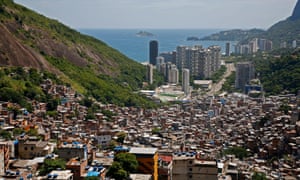
The upper middle-class residents of the South Zone, supposedly beneficiaries of reduced crime in neighbouring favelas, claim to have noticed little difference over the years. “Nothing has changed,” says Eduardo Barbosa, 29, who has lived in Ipanema all his life. “You still hear the shout ‘Catch the thief!’ on the streets here on a regular basis.”
Statistically, however, there has been a significant drop in violent crime since the start of the UPP programme, though the last few months have seen some of those gains begin to reverse. Many Cariocas, as Rio’s residents are known, question whether pacification will last after the Olympics, given the enormous cost, the state’s dire finances and the haemorrhaging of public support.
For Robert Muggah, research director of the Igarapé Institute, the 2013 disappearance of Amarildo de Souza, a bricklayer from the Rocinha favela who was tortured and murdered by officers from the local UPP, marked a turning point for the programme. “Support for the policy is failing,” he says. “People have lost faith.”
Around the picturesque Rodrigo de Freitas lagoon security has never been better, according to Ildo de Souza, who earns a living renting out pedaloes there. But he doesn’t expect it to last. “After the Olympics everything will change,” he said. “The bad guys will be back out in force.” BD
Deodoro and the North Zone
Few Olympic projects have generated as much enthusiasm among locals as the Parque Madureira, the 92,000 sq m park that was opened in 2012.
The huge metal Olympic rings that once adorned the Tyne Bridge in Newcastle now sit in the middle of this park, alongside other attractions such as a samba stage, an artificial beach and a skate park.
Previously, there were virtually no green spaces in Rio’s arid, sprawling and relatively impoverished North Zone. “For me it’s the best thing,” says Greice Lopes, 36, a mother of two. “Before there was nowhere to walk with my kids. If you want a moment to walk, think or pray, this is a wonderful place.” During the Games, the park will be one of three “live sites” where residents will be able to watch the action on huge screens.
Though the space now pleases many locals, City Hall acknowledges 771 families were forced out of the Vila das Torres favela to make way for this long-planned R$278m park, which sits between the Olympic facilities in Deodoro and the two main North Zone stadiums: the João Havelange Olympic Stadium, which will host the athletics, and the Maracanã, which will host the final stages of the football and the opening and closing ceremonies.
“There was a conflict, a lot of resistance,” says Raphaella Santos, a graduate student at Rio de Janeiro’s Rural Federal University who studied the development. “It was very traumatic for a lot of the residents.”
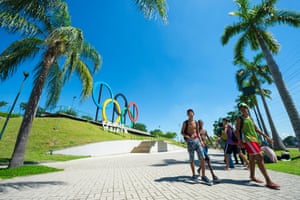
“Rent has gone up a lot round here, and so some people have had to leave,” says Jorge de Souza, 65, a seven-year resident of the Engenho de Dentro suburb, which has been upgraded for the Games at a cost of around R$52m.
Further west, around R$825m has been invested in Deodoro, site of an active military base. Eleven Olympic and four Paralympic events, including equestrianism, wheelchair fencing and rugby, will be held in the area and, for the most part, the Olympic developments have been welcomed by residents of this sleepy corner of Rio.
“Commercially speaking, it’s been great,” says Marco Aurelio, the 47-year-old president of the local residents’ association. “It’s put Deodoro on the map; the flow of business has increased, and the place is attracting investors.”
But many here question whether the authorities have the will and money to maintain the facilities in the long-run. Though the new X-Park – which will host the slalom canoe and BMX competitions – is due to be handed over to the public after the Games, locals remain sceptical: “We don’t know what’s going to happen afterwards,” says Eloy do Nascimento, 58. “I think it could be privatised.” BD
Follow Guardian Cities on Twitter and Facebook and join the discussion



